Overview
Have you ever thought about what makes a product configurator website truly effective? Well, it turns out that there are some essential elements that can really enhance customer engagement and satisfaction. Imagine a website where the interface is super accessible, you can see real-time visualizations of your choices, and pricing updates dynamically as you customize—sounds great, right? These features all come together to create a seamless user experience that not only boosts conversion rates but also builds client loyalty. So, if you're looking to make your website stand out, focusing on these key aspects is a must!
Introduction
Have you ever thought about how a product configurator website could completely change the way businesses connect with their customers? Imagine a shopping experience that’s tailored just for you, meeting your unique preferences. This dynamic tool not only boosts customer satisfaction but also ramps up conversion rates by offering real-time visualization and customization options.
But with personalization becoming a key player in e-commerce, how can companies design and implement a configurator that truly captivates users and fits seamlessly into their existing systems?
Let's dive into this exciting topic together!
Define Product Configurator and Its Importance
Have you ever wished you could customize a product exactly to your liking? Well, that's where a configurator comes in! It's a dynamic tool that lets you tailor items to fit your specific preferences and needs. This feature is especially crucial in industries like manufacturing and distribution, where personalized solutions are often a must. With configurators, clients can visualize and tweak items in real-time, which not only boosts engagement but also reduces decision fatigue—leading to higher conversion rates. It’s all about creating a stronger connection between the client and the brand, something that’s essential in today’s competitive marketplace.
Imagine incorporating a product configurator website into your business strategy. It could significantly enhance client satisfaction and loyalty by providing a seamless and enjoyable purchasing experience. This is particularly important for manufacturers and distributors who face challenges in meeting diverse client needs. Did you know that satisfied clients are 70% more likely to make a purchase? That’s a powerful statistic highlighting how configurators can enhance client engagement.
Take CITY Furniture's 3D Cloud® Sectional Configurator, for example. It has transformed the shopping experience, making it interactive and visually captivating, allowing shoppers to see their custom sectional designs in a 3D environment. By investing in a product configurator website, companies can not only meet but exceed client expectations, which drives growth and reinforces brand loyalty. Plus, modern enterprise configurators come packed with essential features like guided selling and dynamic pricing, making them even more effective at delivering personalized customer experiences.
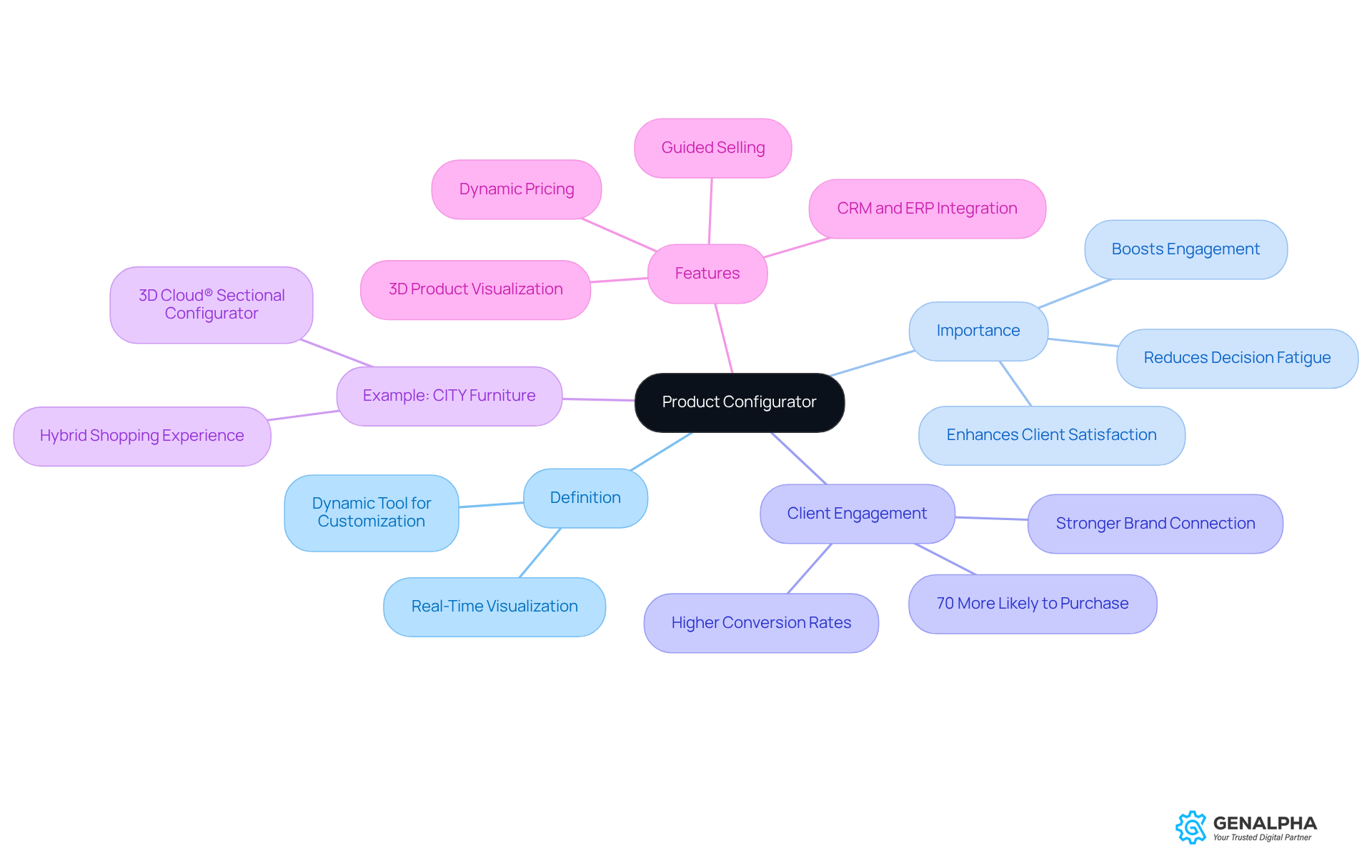
Identify Key Features of an Effective Product Configurator
When it comes to creating an effective product configurator, there are several essential features that can really elevate user experience and boost engagement.
First off, let’s talk about the Accessible Interface. An intuitive setup is key! It should allow users to navigate easily without feeling overwhelmed. Think about it—clear categorization of options and a logical flow help keep users interested and satisfied. Studies have shown that an intuitive interface can significantly enhance conversion rates. After all, clients are much more likely to finalize their purchases if they can easily understand and engage with the tool. Plus, did you know the product configurator market is projected to hit $5.16 billion by 2032? That really underscores how important these tools are becoming in the industry.
Next, there’s Real-Time Visualization. Customers love being able to see their customizations as they make them, whether it’s through 2D images or 3D models. This instant visual feedback not only boosts engagement but also increases satisfaction, allowing users to really visualize their selections before committing.
Then we have Dynamic Pricing. Implementing real-time pricing updates based on customer selections is a game changer! It fosters transparency and helps customers manage their budgets effectively, which is especially crucial in the manufacturing sector where complex configurations can lead to varying costs.
Let’s not forget about Integration Capabilities. A configurator should seamlessly connect with existing eCommerce platforms and ERP systems. This is essential for manufacturers looking to modernize their processes without completely overhauling their entire system.
With mobile shopping on the rise, Mobile Compatibility is more important than ever. Ensuring that the configurator is mobile-friendly broadens the audience reach. A responsive design allows users to customize products on the go, making it all about accessibility and convenience.
Lastly, we have Analytics and Reporting. Incorporating analytics tools enables businesses to track user behavior and preferences, which provides valuable insights for future improvements and targeted marketing strategies. Understanding how clients engage with the setup tool can guide design modifications and feature enhancements.
Recent advancements in customization technology, like the launch of Version 3.0, really highlight the importance of intuitive interfaces. Michal Stachowski, the chief commercial officer, mentioned that Configurator 3.0 is designed to empower everyone in the commerce chain, enhancing the buying process and future-proofing digital strategies. Additionally, platforms like Imagine.io are leading the charge in offering high-quality visuals and interactive features that meet the evolving needs of manufacturers and distributors. By prioritizing these key features, businesses can create effective configurators that not only meet customer expectations but also drive sales and enhance operational efficiency.
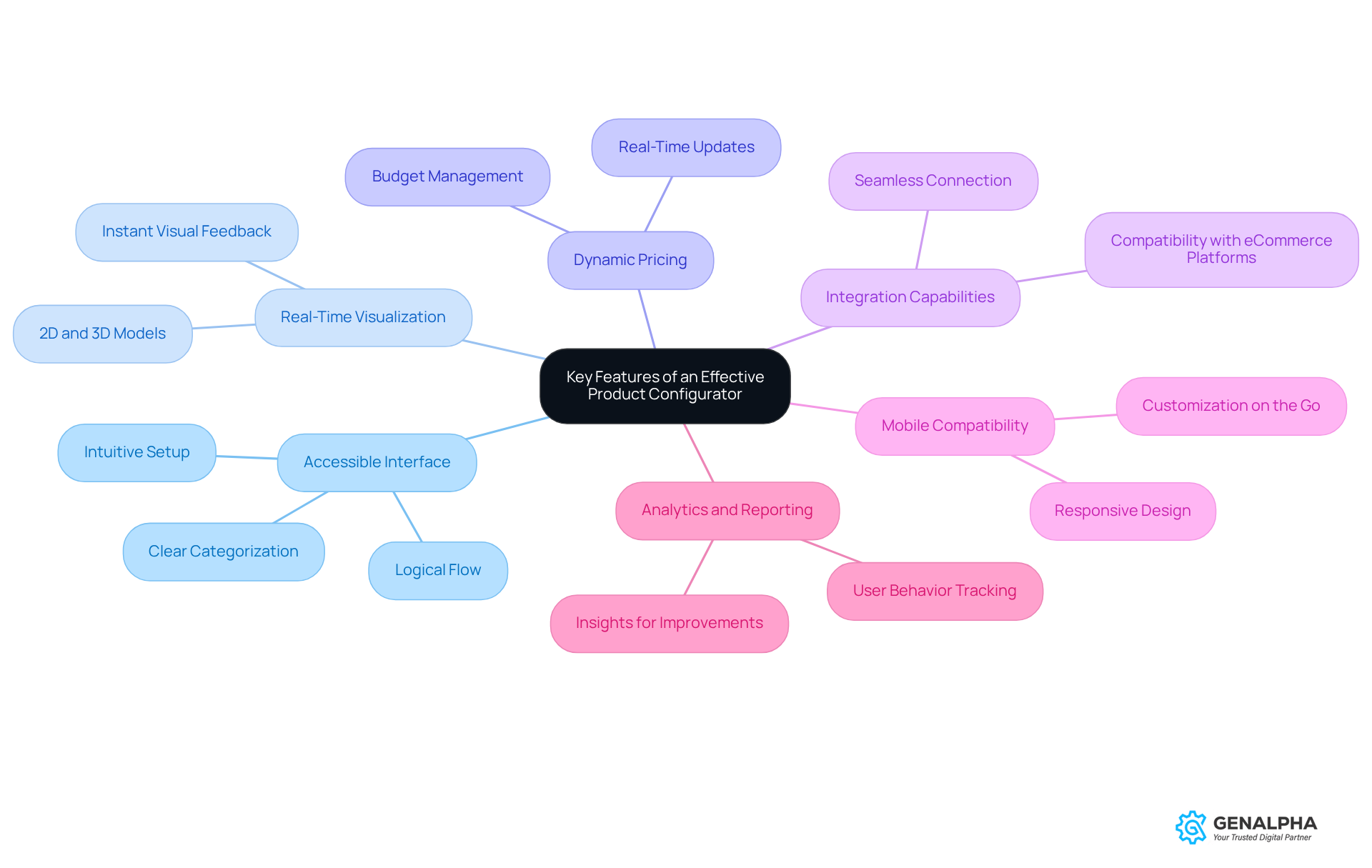
Design an Intuitive User Interface for Your Configurator
Designing an intuitive user interface for your product configurator can be a game changer! Here are some steps to help you get started:
-
User Research: First things first—let’s get to know your audience! Conduct surveys or interviews to gather insights on what they like and what frustrates them. This step is crucial; it can save you from costly redesigns by pinpointing potential issues early on.
-
Wireframing: Next, create wireframes to sketch out the layout of your configurator. Focus on grouping features into clear categories like Color, Material, and Size. This way, you won’t overwhelm users with too many choices at once.
-
Visual Hierarchy: Think about how to guide users through the configuration process. Use visual hierarchy to spotlight the most important options and actions, making them easy to find.
-
Feedback Mechanisms: Don’t forget to add feedback mechanisms! Tooltips or confirmation messages can be super helpful to keep users informed about their selections and any changes they make.
-
Testing and Iteration: Now, it’s time for some real-world testing. Bring in actual users to identify any hiccups or areas for improvement. Use their feedback to refine your design, ensuring it truly meets their needs.
-
Accessibility Considerations: Finally, make sure your tool is accessible to everyone, including those with disabilities. This could mean using good color contrasts, providing alt text for images, and ensuring keyboard navigation is an option.
By following these steps, you’ll be well on your way to creating a user-friendly configurator that everyone can enjoy!
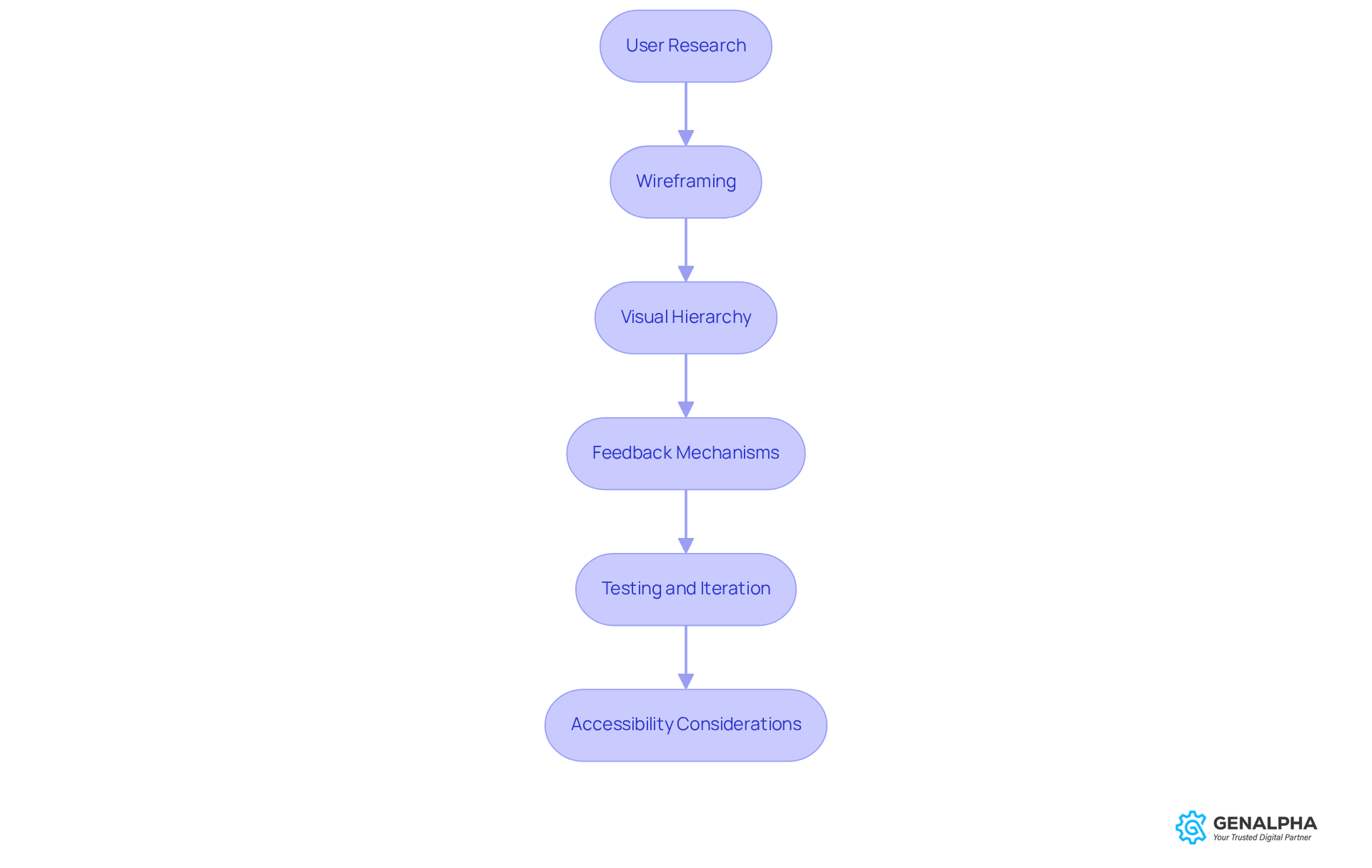
Implement Real-Time Updates and Pricing Transparency
To effectively implement real-time updates and pricing transparency in your product configurator, let's explore some friendly guidelines:
-
Dynamic Pricing Engine: Imagine having a dynamic pricing engine that automatically adjusts prices based on your selections. This way, you always see the most accurate pricing, boosting your confidence in purchasing. As some companies have found, "implementing real-time solutions frequently leads to enhanced customer retention on item pages."
-
Instant Feedback: How about providing immediate feedback on how your configuration changes affect the product and its price? For example, if you choose a premium material, the price should update right away, reinforcing the connection between your choice and the cost.
-
Clear Pricing Breakdown: It’s essential to offer a detailed breakdown of costs for each customization option. This transparency helps you understand your expenditures, building trust in the purchasing process and minimizing any potential disputes. A case study shows that configurators improve pricing clarity by delivering instant pricing details based on client configurations, fostering trust and reducing misunderstandings.
-
Inventory Updates: What if you could see real-time inventory levels for customizable components? This feature helps prevent you from selecting out-of-stock options, significantly enhancing your overall experience and satisfaction.
-
User Notifications: Implementing notifications can keep you informed of any changes in pricing or availability as you configure your products. Staying engaged and informed throughout the process is crucial for maintaining your interest and trust.
-
Testing for Accuracy: Lastly, it’s important to regularly test the configurator to ensure all updates are accurate and functioning correctly. This includes checking pricing and inventory levels to avoid inconsistencies that could shake your confidence. As industry experts emphasize, maintaining accuracy in these updates is essential for building lasting customer relationships.
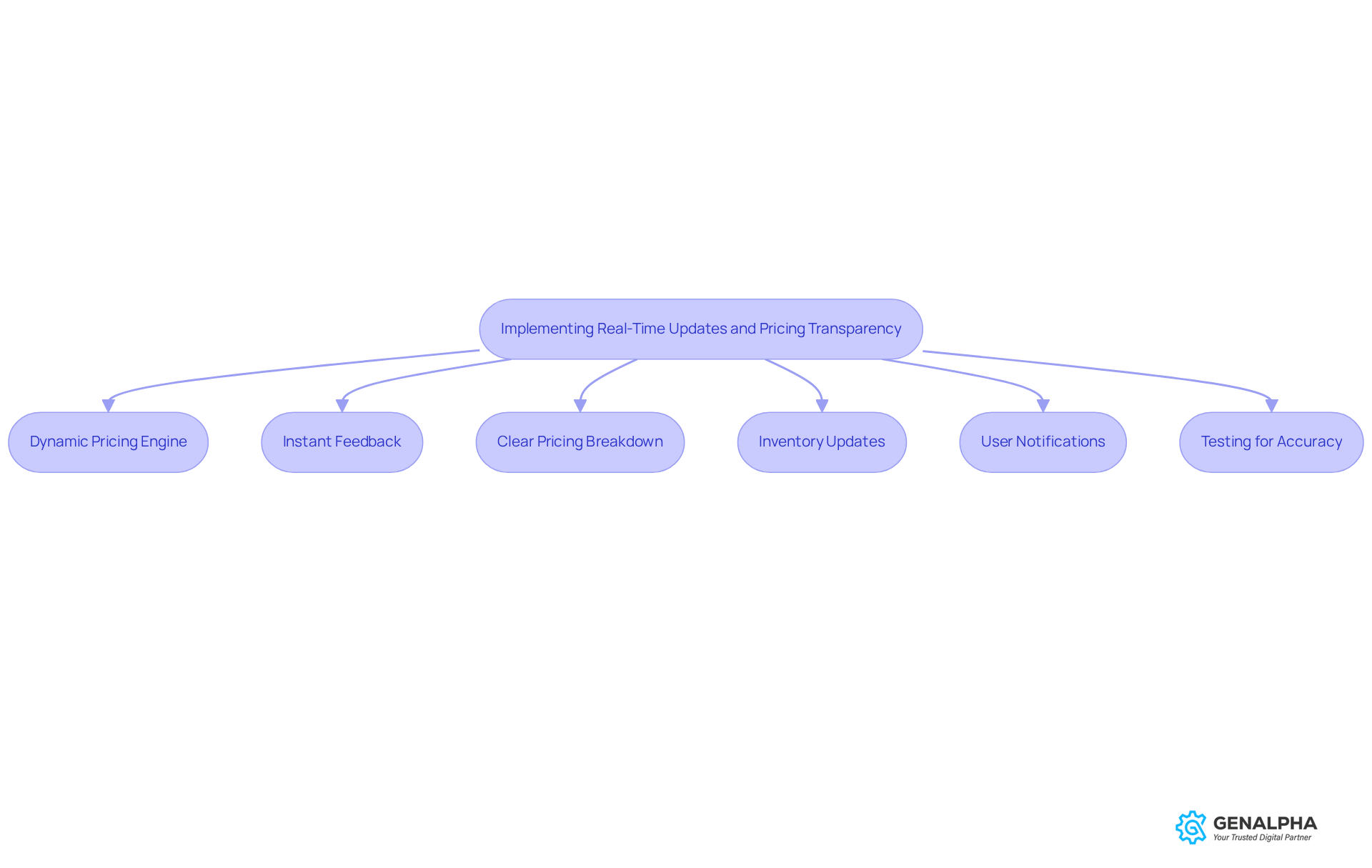
Promote Your Product Configurator to Drive Engagement
To effectively promote your product configurator and drive engagement, let’s explore some strategies together:
-
Leverage Social Media: Have you thought about using social media platforms to showcase your tool’s features and benefits? Sharing user-generated content, like custom designs created by your customers, can really foster community participation. Plus, did you know that 58% of consumers find it more engaging to connect with a brand on social media than to visit a physical store? This highlights just how important this channel is.
-
Email Marketing Campaigns: Why not create focused email campaigns that highlight your tool's features? Incorporating tutorials or success stories can illustrate its value and enhance the likelihood of engagement. Effective campaigns can significantly boost interest and utilization of your tool.
-
SEO Optimization: It’s crucial to ensure your website and content are optimized for search engines to attract organic traffic. Using keywords associated with customization and the product configurator website can improve visibility and help you connect with potential audiences effectively. Remember, effective SEO can lead to increased traffic and engagement.
-
Incentives for Use: Consider offering incentives, like discounts or exclusive deals, for those who use the tool to create their products. This strategy can really enhance user engagement and motivate more clients to explore what you have to offer.
-
Webinars and Demos: How about arranging webinars or live demonstrations to display the tool's capabilities? These sessions can help potential customers understand its benefits and encourage them to engage. Highlighting successful case studies, like a furniture retailer that boosted click-through rates by 30% through dynamic 3D renderings, can really illustrate the effectiveness of these strategies.
-
Partnerships and Collaborations: Collaborating with influencers or industry partners can expand your reach. Their endorsements can enhance credibility and attract new users to your configurator, leveraging their established audiences for greater impact. As noted by industry leaders, creating interactive experiences through social media is critical for success, with 90% of businesses agreeing on its importance.
So, which strategy resonates with you the most? Let’s dive in and make it happen!
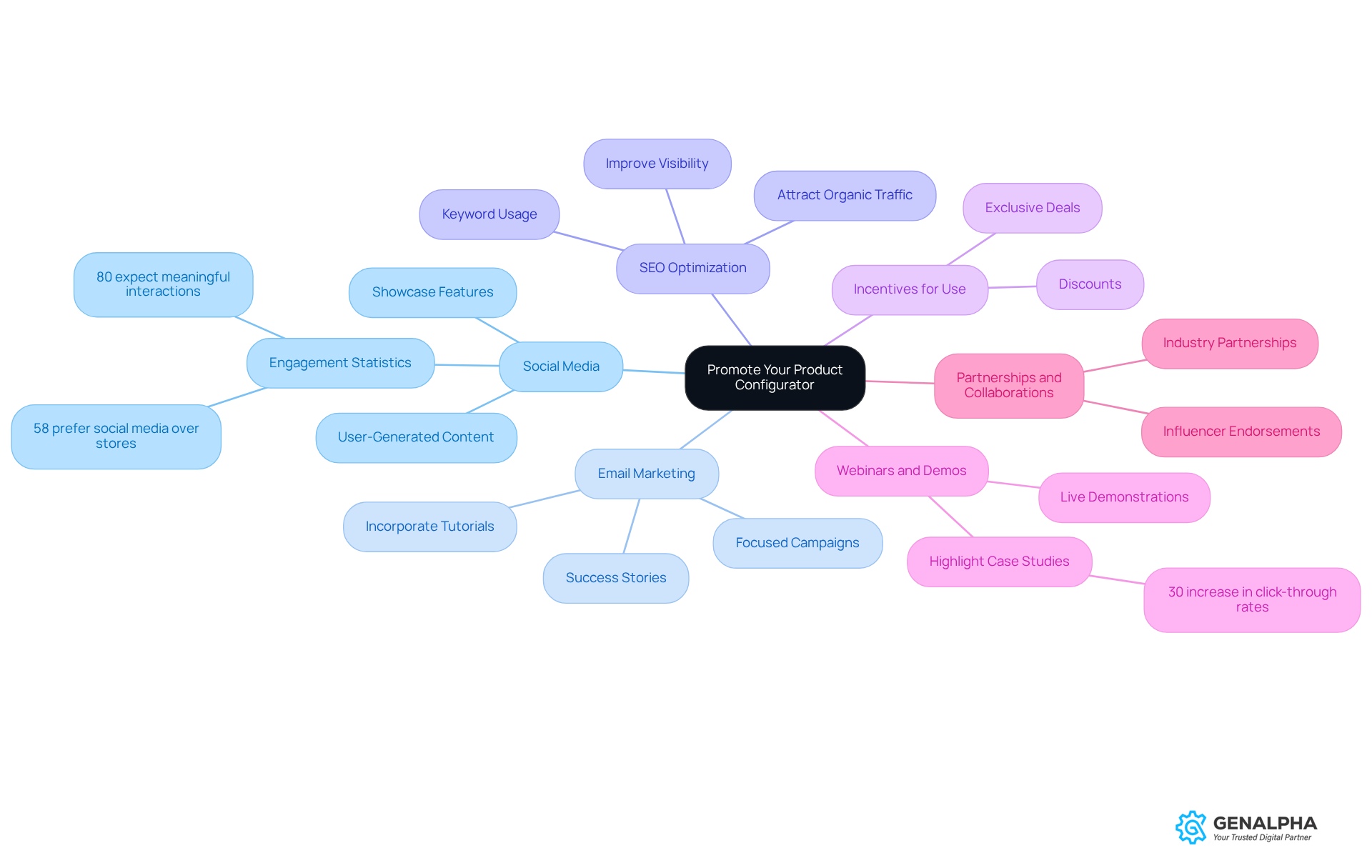
Conclusion
Wrapping up our discussion on product configurators, it’s clear that building an effective website is a game changer for businesses eager to boost customer engagement and satisfaction. Imagine being able to offer personalized experiences that truly resonate with your clients—this not only fosters loyalty but also drives those all-important sales. Real-time customization of products not only meets diverse client needs but also helps your brand stand out in a crowded marketplace.
Throughout this guide, we’ve highlighted essential features like:
- An accessible interface
- Real-time visualization
- Dynamic pricing
- Mobile compatibility
These elements are crucial for creating a successful product configurator. And let’s not forget the importance of user research, intuitive design, and transparent pricing; these factors play a huge role in enhancing user experience and improving conversion rates. Plus, effective promotion strategies, such as engaging on social media and optimizing for SEO, are vital for attracting traffic and encouraging interaction with your configurator.
Incorporating a product configurator goes beyond just a tech upgrade; it’s a commitment to understanding and serving your customers in a dynamic way. As businesses evolve, using these tools can lead to stronger customer relationships and sustained growth. By embracing this innovative approach, you’re not just enhancing the purchasing journey—you’re positioning your brand for long-term success in our increasingly digital world. So, are you ready to take the plunge and transform your customer experience?
Frequently Asked Questions
What is a product configurator and why is it important?
A product configurator is a dynamic tool that allows clients to customize products according to their specific preferences and needs. It is particularly important in industries like manufacturing and distribution, as it enhances client engagement, reduces decision fatigue, and leads to higher conversion rates by creating a stronger connection between the client and the brand.
How can a product configurator enhance client satisfaction?
A product configurator can significantly enhance client satisfaction by providing a seamless and enjoyable purchasing experience. It allows clients to visualize and tweak items in real-time, which meets diverse client needs and increases the likelihood of making a purchase.
Can you give an example of a successful product configurator?
An example of a successful product configurator is CITY Furniture's 3D Cloud® Sectional Configurator. It transforms the shopping experience by allowing customers to see their custom sectional designs in a 3D environment, making the process interactive and visually captivating.
What are some key features of an effective product configurator?
Key features of an effective product configurator include: - Accessible Interface: An intuitive setup that allows easy navigation. - Real-Time Visualization: Instant visual feedback through 2D images or 3D models. - Dynamic Pricing: Real-time pricing updates based on customer selections. - Integration Capabilities: Seamless connection with existing eCommerce platforms and ERP systems. - Mobile Compatibility: A mobile-friendly design for customization on the go. - Analytics and Reporting: Tools to track user behavior and preferences for future improvements.
Why is an accessible interface important for a product configurator?
An accessible interface is important because it enhances user experience and boosts engagement. Clear categorization of options and a logical flow help keep users interested and satisfied, increasing the likelihood of finalizing purchases.
How does real-time visualization benefit customers using a configurator?
Real-time visualization benefits customers by allowing them to see their customizations as they make them, which increases satisfaction and helps them visualize their selections before committing to a purchase.
What role does dynamic pricing play in a product configurator?
Dynamic pricing fosters transparency by providing real-time pricing updates based on customer selections. This helps customers manage their budgets effectively, which is particularly crucial in sectors like manufacturing where configurations can lead to varying costs.
Why is mobile compatibility important for product configurators?
Mobile compatibility is important because it broadens the audience reach, allowing users to customize products on the go. A responsive design enhances accessibility and convenience for customers who prefer mobile shopping.
How can analytics and reporting improve a product configurator?
Analytics and reporting can improve a product configurator by enabling businesses to track user behavior and preferences. This provides valuable insights for future improvements and targeted marketing strategies, guiding design modifications and feature enhancements.




